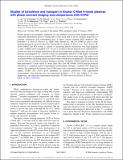Studies of turbulence and transport in Alcator C-Mod H-mode plasmas with phase contrast imaging and comparisons with GYRO
Author(s)
Lin, Liang; Porkolab, Miklos; Edlund, Eric Matthias; Rost, Jon C.; Fiore, Catherine L.; Greenwald, Martin J.; Mikkelsen, David; Tsujii, Naoto; Wukitch, Stephen James; ... Show more Show less
DownloadLin_Studies of turbulence.PDF (899.1Kb)
PUBLISHER_POLICY
Publisher Policy
Article is made available in accordance with the publisher's policy and may be subject to US copyright law. Please refer to the publisher's site for terms of use.
Terms of use
Metadata
Show full item recordAbstract
Recent advances in gyrokinetic simulation of core turbulence and associated transport requires an intensified experimental effort to validate these codes using state of the art synthetic diagnostics to compare simulations with experimental data. A phase contrast imaging (PCI) diagnostic [M. Porkolab, J. C. Rost, N. Basse et al., IEEE Trans. Plasma Sci. 34, 229 (2006)] is used to study H-mode plasmas in Alcator C-Mod [M. Greenwald, D. Andelin, N. Basse et al., Nucl. Fusion 45, S109 (2005)]. The PCI system is capable of measuring density fluctuations with high temporal (2 kHz–5 MHz) and wavenumber (0.5–55 cm[superscript −1]) resolution. Recent upgrades have enabled PCI to localize the short wavelength turbulence in the electron temperature gradient range and resolve the direction of propagation (i.e., electron versus ion diamagnetic direction) of the longer wavelength turbulence in the ion temperature gradient (ITG) and trapped electron mode range. The studies focus on plasmas before and during internal transport barrier formation in an enhanced Dalpha H-mode plasma assisted with ion cyclotron resonance frequency heating. Nonlinear GYRO simulations have also been performed [J. Candy and R. E. Waltz, Phys. Rev. Lett. 91, 045001 (2003)] and the predicted fluctuation is compared against experimental measurements through a synthetic PCI diagnostic method. The simulated fluctuations from GYRO agree with experimental measurements in the ITG regime. GYRO also shows good agreement in transport predictions with experimental measurements after reducing the ion temperature gradient (~15%) and adding E×B shear suppression, all within the experimental uncertainty.
Date issued
2009-01Department
Massachusetts Institute of Technology. Department of Physics; Massachusetts Institute of Technology. Plasma Science and Fusion CenterJournal
Physics of Plasmas
Publisher
American Institute of Physics
Citation
Lin, L. et al. “Studies of turbulence and transport in Alcator C-Mod H-mode plasmas with phase contrast imaging and comparisons with GYRO.” Physics of Plasmas 16.1 (2009): 012502-9. ©2009 American Institute of Physics.
Version: Final published version
ISSN
1070-664X